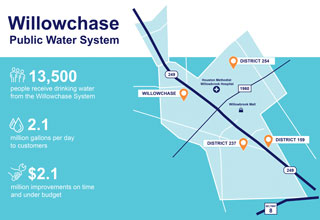Collaborative Approach Enables Improvements at Texas Groundwater Facilities (Source: Pumps & Systems)
By Melissa Mack
Houston Public Works provides drinking water to its communities through six public water systems. One of the systems, the Willowchase system, provides water to approximately 13,500 people and relies solely on groundwater. Four facilities in the system—Willowchase, Centerfield District 254, Willowbrook District 159 and Willowbrook West District 237—provide an average of 2.1 million gallons per day to customers. Originally, these groundwater facilities, which were constructed more than three decades ago, were operated by municipal utility districts. Later, ownership and operations of these facilities were transferred to Houston Public Works.
In June 2014, Houston Public Works began implementation of improvements to 11 drinking water facilities, including the four in the Willowchase system, to optimize operations, streamline maintenance activities and replace worn-out and obsolete equipment. A national planning, engineering and program management firm was hired to design these improvements. Specifically, the improvements included replacement/rehabilitation of booster pumps, isolation and control valves, above ground piping and related appurtenances, as well as electrical and supervisory control and data acquisition (SCADA) components.
To start, the engineering firm performed a comprehensive evaluation of all the facilities in the Willowchase system. The project team reviewed available record drawings, took photos, collected data, carried out site investigations, tested the equipment and performed engineering analyses. In certain cases, the record drawings did not match the site observations. To reconcile the differences, the project team created sketches and computer-aided design (CAD) drawings to develop a basis for the design. The project team also held discussions with Houston Public Works’ operations staff, listened to their concerns, and added the improvements needed at various sites. These included replacing motor control centers to improve reliability, adding butterfly valves to minimize impacts of water line shutdowns, making SCADA changes to meet current standards, and upgrading the drainage at one of the facilities.
CLICK HERE TO READ COMPLETE STORY

